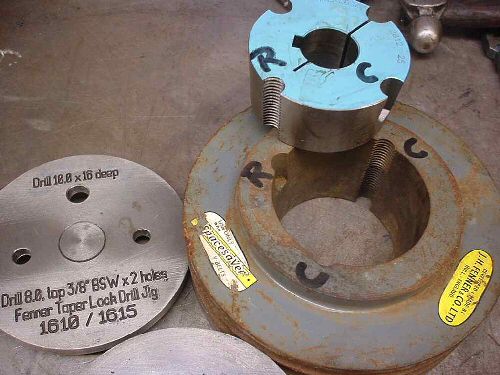Using a jig for doing a taperlock bush yesterday and it struck me as possibly not many people appreciate the use of these items.
A pic of what I'm talking about.
The bushes come in various ranges that denote the same outside dimensions and in that range you get various bore sizes.
The one in the picture covers the 1610 and 1615 bush series.
You can rebore and key to suit the application. I tend to keep some of the lowest sizes in stock for emergencies.
Forgive me if I'm teaching people to suck eggs but some won't have seen these and they are a life saver.
The bush is tapered and fits into a tapered hole in the gear or pulley. There are two 'nearly' opposite holes that are 1/2 holes running partway down the side, marked C on the bush. These mate up with two tapped holes running thru in the pulley, again marked as C.
The principle is you fit the bush to the pulley then onto the shaft and tighten the two allen grub screws supplied into the two holes marked C, these hit the bottom of the bush and force the taper bush into the pulley to lock the whole assembly very tightly together.
Opposite the two clapming holes is an extra hole marked R, this is the release hole and is machined opposite the the clamp holes i.e. blind hole in the pulley, threaded hole in the bush. To release the bush you remove both allen screws and replace one in the release hole, when it hits the bottom of the blind hole it jacks the bush out. Very neat, no pullers or hammers.
To use these in a pulley that has a parent bore or a normal bore that's been damaged you need to mark out the three holes on the pulley, drill one blind, drill two thru and tap and then machine the taper to give the 1/2 holes. The holes in each bush range are unique, no range has the same layout and they are never at 180 or 90 degrees to each other.
I managed to get the relevant information from Fenner, the inventors of this system, a few years ago and have made a series of jig plates up. I lay the plate on the pulley using an adaptor bush and spot the holes, drill and tap, then machine the taper.
All the tapers are 4 degree's per side, 8 degree's included.
If anyone wants I can supply the jig plate dimensions either as DWG or DXF files for the ranges that appeals most to the home shop.
These bushes are quite chaep, easily obtained and save having to wels up or resleeve damaged pulleys. It also possible to swap pullies between application just by changing the bush.
John S.
Nottingham, England.





